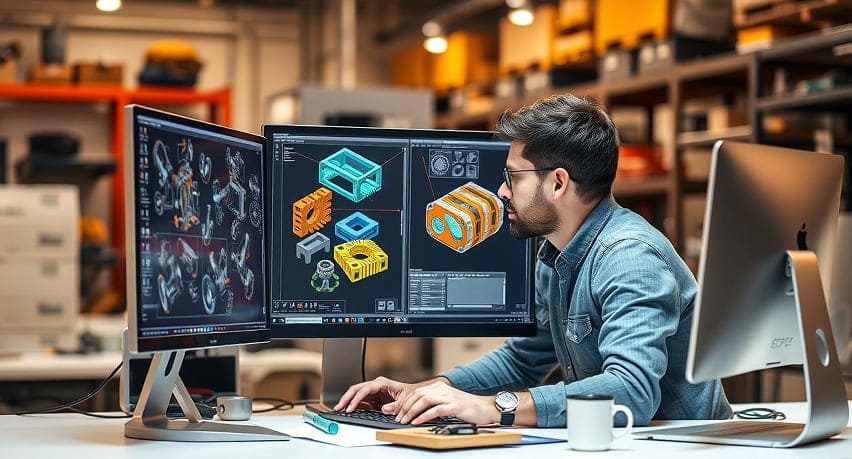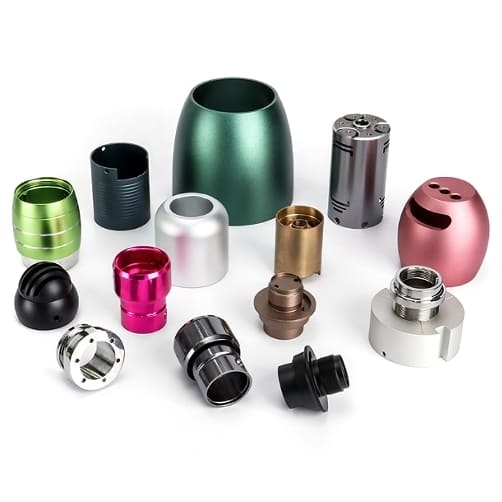
Hello there! If you’re diving into the world of CNC milling, you might be wondering what the best software is for beginners. Choosing the right software can make a huge difference in your learning curve and the quality of your projects. In this article, I’ll guide you through the essentials of CNC software, its working mechanism, and the different types available. By the end, you’ll have a clear idea of how to choose the best software for your needs.
What is CNC Software?
CNC (Computer Numerical Control) software is a type of program that helps you design and control CNC machines. These machines can cut, drill, and shape various materials like wood, metal, and plastic with incredible precision. CNC software acts as a bridge between your design ideas and the physical world, translating your digital designs into machine-readable instructions.
- CAD (Computer-Aided Design) Software: This is where you create your designs. Think of it as your digital drawing board. CAD software allows you to create 2D and 3D models of the parts you want to manufacture.
- CAM (Computer-Aided Manufacturing) Software: This is where you translate your design into instructions that your CNC machine can understand. CAM software takes your CAD model and generates the G-code, which is the language that tells the machine how to move its cutting tools to create the part.
Why is CNC Milling Software Important?
Before we dive into the software options, let’s talk about why the right software is so important. CNC milling software serves as the brain of your CNC machine. It helps you design, simulate, and generate the toolpaths that your machine will follow to cut materials. Without the right software, you might find yourself struggling to create accurate designs, optimize your toolpaths, and ensure the safety of your machine and materials.
Key Features to Look For
When evaluating CNC milling software, there are several key features to consider:
- User-Friendliness: The software should have an intuitive interface that is easy to navigate, especially for beginners.
- Design Capabilities: It should allow you to create and edit designs, import 2D and 3D models, and perform basic CAD functions.
- Simulation: A good simulation feature can help you visualize the entire milling process, identify potential issues, and optimize your toolpaths.
- Toolpath Generation: The software should generate accurate and efficient toolpaths that are compatible with your CNC machine.
- Support and Community: Look for software with a strong support system and an active community of users who can offer advice and assistance.
The Working Mechanism of CNC Software
CNC software operates in a few key steps:
- Designing: You start by creating a digital model of your project using CAD (Computer-Aided Design) software. This model is the blueprint for your CNC machine to follow.
- Toolpaths: Once you have your design, you use CAM (Computer-Aided Manufacturing) software to create toolpaths. Toolpaths are the specific routes your CNC machine will follow to cut the material. This step is crucial for ensuring that your machine operates efficiently and safely.
- G-Code Generation: The CAM software converts the toolpaths into G-Code, a programming language that CNC machines understand. G-Code tells the machine exactly what to do, step by step.
- Machine Control: Finally, the G-Code is sent to the CNC machine, which executes the instructions to create your design.
Different Types of CAD Software
CAD software is the first step in the CNC process. Here are some popular options:
1. Fusion 360
- Pros: Comprehensive features, cloud-based, free for hobbyists and startups.
- Cons: Steep learning curve, requires a powerful computer.
2. SolidWorks
- Pros: Industry-standard, highly detailed designs.
- Cons: Expensive, complex for beginners.
3. FreeCAD
- Pros: Open-source, free, lightweight.
- Cons: Limited features compared to paid software.
4. SketchUp
- Pros: User-friendly, great for 3D modeling.
- Cons: Not as powerful for complex designs.
Different Types of CAM Programs
CAM software is where you create the toolpaths and generate G-Code. Here are some popular options:
1. Fusion 360
- Pros: Integrated with CAD, powerful features, free for hobbyists.
- Cons: Steep learning curve, resource-intensive.
2. CamBam
- Pros: Affordable, easy to use, good for 2D and 3D projects.
- Cons: Limited features compared to Fusion 360.
3. VCarve
- Pros: User-friendly, great for woodworkers.
- Cons: Can be expensive.
4. BobCAD-CAM
- Pros: Robust features, suitable for both beginners and professionals.
- Cons: Steep learning curve, expensive.
Different Types of Control CNC Software
Control software is used to send G-Code to your CNC machine and monitor its operation. Here are some popular options:
1. Mach3
- Pros: Versatile, supports a wide range of machines.
- Cons: Can be complex to set up.
2. LinuxCNC
- Pros: Open-source, highly customizable.
- Cons: Requires some technical knowledge.
3. Smoothieboard
- Pros: Integrated hardware and software, easy to use.
- Cons: Limited to specific hardware.
4. UCCNC
- Pros: User-friendly, good for hobbyists.
- Cons: Limited features compared to Mach3.
Comparison Table
| Software | Type | Pros | Cons | Best For |
|---|---|---|---|---|
| Fusion 360 | CAD/CAM | Comprehensive, free for hobbyists | Steep learning curve, resource-intensive | Beginners and professionals |
| SolidWorks | CAD | Industry-standard, highly detailed | Expensive, complex for beginners | Professionals |
| FreeCAD | CAD | Open-source, free, lightweight | Limited features | Budget-conscious beginners |
| SketchUp | CAD | User-friendly, great for 3D modeling | Not as powerful | Beginners |
| CamBam | CAM | Affordable, easy to use | Limited features | Beginners |
| VCarve | CAM | User-friendly, great for woodworkers | Can be expensive | Woodworkers |
| BobCAD-CAM | CAM | Robust features, suitable for both beginners and professionals | Steep learning curve, expensive | Intermediate to advanced users |
| Mach3 | Control | Versatile, supports a wide range of machines | Can be complex to set up | Intermediate to advanced users |
| LinuxCNC | Control | Open-source, highly customizable | Requires technical knowledge | Advanced users |
| Smoothieboard | Control | Integrated hardware and software, easy to use | Limited to specific hardware | Beginners |
| UCCNC | Control | User-friendly, good for hobbyists | Limited features | Beginners |
How to Choose the Best CNC Software for You?
Choosing the right CNC software can be overwhelming, but here are some steps to help you make the best decision:
1. Assess Your Needs
- Beginner: Look for user-friendly software with a gentle learning curve.
- Intermediate: Consider software with more advanced features and a larger community for support.
- Professional: Opt for industry-standard software with robust features and detailed documentation.
2. Consider Your Budget
- Free: Options like FreeCAD and CamBam are great for beginners.
- Affordable: CamBam and VCarve offer good value for their price.
- Premium: Fusion 360 and SolidWorks are top-tier but can be expensive.
3. Evaluate the User Interface
- User-Friendly: Software with an intuitive interface can save you a lot of time and frustration.
- Customizable: Some software allows you to customize the interface to suit your workflow.
4. Check the Community and Support
- Active Community: A large and active community can provide valuable resources and support.
- Customer Support: Good customer support can be crucial, especially when you encounter issues.
5. Test Before You Buy
- Free Trials: Many software options offer free trials, so you can test them out before committing.
Key Considerations for Beginners
When choosing CNC software as a beginner, keep these factors in mind:
- Ease of Use: A user-friendly interface and intuitive workflow are crucial. You don’t want to spend hours struggling to figure out basic commands.
- Learning Resources: Look for software with ample tutorials, documentation, and a supportive community.
- Affordability: Some software packages are very expensive. Consider your budget and look for options that offer free trials, student licenses, or affordable subscription plans.
- Compatibility: Make sure the software is compatible with your CNC machine and its controller.
- Functionality: While advanced features might be tempting, focus on the core functionalities you need to get started, such as 2.5D milling, pocketing, drilling, and profiling.
- System Requirements: Ensure your computer meets the minimum system requirements for the software to run smoothly.
FAQs
1. What is the difference between CAD and CAM software?
- CAD is used for creating digital designs, while CAM is used for generating toolpaths and G-Code.
2. Is CNC software difficult to learn?
- It can be, especially for beginners. However, many software options offer tutorials and user-friendly interfaces to help you get started.
3. Can I use CNC software on a low-end computer?
- Some software, like FreeCAD and CamBam, are lightweight and can run on less powerful computers. However, more advanced software like Fusion 360 requires a more powerful system.
4. Do I need to know programming to use CNC software?
- No, you don’t need to know programming. Most CNC software is designed to be user-friendly and guides you through the process.
5. Can I use CNC software for 3D printing?
- While some CNC software can be used for 3D printing, it’s generally more specialized. For 3D printing, you might want to look into software like Cura or PrusaSlicer.
Conclusion
Choosing the best CNC software for beginners involves considering your needs, budget, and the level of support you require. Fusion 360 is a great all-around option, offering both CAD and CAM features and a free version for hobbyists. However, if you’re looking for something more affordable and user-friendly, CamBam or VCarve might be the way to go.
I hope this guide helps you find the perfect CNC software for your needs. Happy machining!
